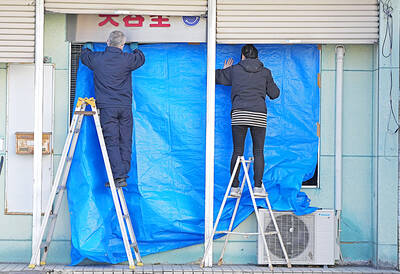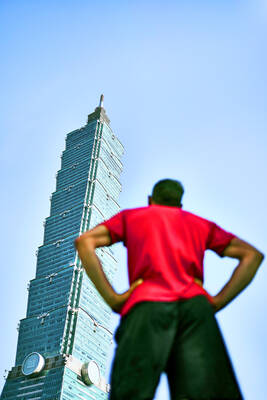Her eyes lit bright with concentration, Taiwanese linguist Sung Li-may (宋麗梅) leans in expectantly as one of the planet’s last 10 speakers of the Kanakanavu language shares his hopes for the future.
“I am already very old,” says 80-year-old Mu’u Ka’angena, a leathery-faced man with a tough, sinewy body and deeply veined hands.
A light rain falls onto the thatched roof of the communal bamboo hut, and smoke from a dying fire drifts lazily up the walls, wafting over deer antlers, boar jawbones and ceremonial swords that decorate the interior like trophies from a forgotten time.
“Every day I think: Can our language be passed down to the next generation? It is the deepest wish in my heart that it can be,” he says.
Kanakanavu, Sung says, has a lot more going for it than just its intrinsic value. It belongs to the same language family that experts believe spread from Taiwan 4,000 years ago, giving birth to languages spoken today by 400 million people in an arc extending from Easter Island off South America to Madagascar, off Africa.
“Taiwan is where it all starts,” says archeologist Peter Bellwood, who with linguist Robert Blust developed the now widely accepted theory that people from Taiwan leveraged superior navigation skills to spread their Austronesian language far and wide. At least four of Taiwan’s 14 government-recognized Aboriginal languages are still spoken by thousands of people, but a race is on to save the others from extinction.
The youngest good speaker of Kanakanavu, also known as Southern Tsou, is 60, and the next-youngest, 73.
“To survive a language has to be spoken,” Sung said. “And with this one it isn’t happening.”
It’s a story repeated in the remote corners of the earth, as younger generations look to the dominant language for economic survival and advancement, whether it be English or, in Taiwan’s case, Mandarin.
Aborigines account for only 2 percent of the Taiwanese population of 23 million. Many young people are leaving Dakanua, a picturesque village in the south that is home to the Kanakanavu language, to work in the cities.
Sung is clearly revered by Dakanua’s tiny cadre of Kanakanavu speakers, who are happy to spend long hours going over their language with her and a small group of graduate students she brings to the village from National Taiwan University in Taipei.
On a recent Saturday afternoon, they sat outside a well-ordered cluster of whitewashed concrete buildings, painstakingly documenting the proper use of the imperative and the grammatical subtleties of concepts like “it could be that” or “it is possible that.”
In the background the bamboo and palm tree covered contours of Mount Anguana protruded through a moving blanket of fog and mist, and a thin rain fell in the Nanzihsian River (楠梓仙溪) valley below.
Life here is defined by farming, a reverent belief in Christianity — Presbyterian and Roman Catholic missionaries converted almost two-thirds of the Aboriginal population in the 1930s and 1940s — and chronic concern about the harsh elements. Five hundred residents in the nearby Siaolin Village (小林) were buried alive three-and-a-half years ago when torrential rains unleashed by a typhoon sent thousands of tonnes of mud cascading down onto their homes.
Sung started working with Aboriginal languages almost by accident. After returning to Taiwan in 1994 as a newly minted doctor of linguistics from the University of Illinois, her department head at National Taiwan University pushed her into the discipline, insisting that Taiwan’s majority Chinese population had to understand more about its Aboriginal minority.
“At first I was intimidated,” says Sung, now the director of the university’s Graduate Institute of Linguistics, one of a handful of Taiwanese bodies seeking the preservation of the Aboriginal languages as part of a wide-ranging effort funded by the government.
“I had no idea of how to carry out my field work among the Aboriginals. But over time I got used to it. And I learned the importance of Taiwanese Aboriginal languages in the overall scheme of Austronesian dispersion,” she says.
The deep-rooted linguistic seeds the dispersal sowed have now morphed into dozens of languages — Malay for example, and the Philippines’ Tagalog — that make Austronesian one of the largest language groups in the world.
The dispersion is illustrated by the similarities of the words for “ear.” What linguists call the proto-form — the Taiwanese basis from thousands of years ago — is usually rendered as galinga. In modern Taiwanese Aboriginal dialects that becomes calinga, while in the Philippines it’s tenga, in Fiji dalinga, in Samoa talinga and in Papua New Guinea taringa.
Taiwanese Aborigines traveling to New Zealand, for example, are struck by the close relationship of their own languages to Maori, particularly when they hear the local version of numbers.
Sung’s most recent project was collating a Chinese-English dictionary for the Sediq language spoken by the tribe of Taiwanese mountain dwellers memorialized inWarriors of the Rainbow: Seediq Bale , a 2011 film recounting their rebellion against Japanese occupiers in the 1930s.
In February last year she began her work with Kanakanavu, hoping she can preserve the language before the last speakers die out. The odds against her are long. Even many 40 and 50-year olds are incapable of mouthing anything more than a few simple phrases in their native tongue.
Still, frolicking on the neatly cut lawn of Dakanua’s deserted bed and breakfast is a three-year-old girl with a runny nose, an infectious smile and a lovely lilt to her voice.
She is the granddaughter of Mu’u Ka’angena, the man with the leathery skin, and just within earshot she begins conversing with him in very simple Kanakanavu.
“Did you hear that?” Sung asks. “Isn’t it wonderful? She’s our hope for the future.”

Taiwanese were praised for their composure after a video filmed by Taiwanese tourists capturing the moment a magnitude 7.5 earthquake struck Japan’s Aomori Prefecture went viral on social media. The video shows a hotel room shaking violently amid Monday’s quake, with objects falling to the ground. Two Taiwanese began filming with their mobile phones, while two others held the sides of a TV to prevent it from falling. When the shaking stopped, the pair calmly took down the TV and laid it flat on a tatami mat, the video shows. The video also captured the group talking about the safety of their companions bathing

US climber Alex Honnold is to attempt to scale Taipei 101 without a rope and harness in a live Netflix special on Jan. 24, the streaming platform announced on Wednesday. Accounting for the time difference, the two-hour broadcast of Honnold’s climb, called Skyscraper Live, is to air on Jan. 23 in the US, Netflix said in a statement. Honnold, 40, was the first person ever to free solo climb the 900m El Capitan rock formation in Yosemite National Park — a feat that was recorded and later made into the 2018 documentary film Free Solo. Netflix previewed Skyscraper Live in October, after videos

Starting on Jan. 1, YouBike riders must have insurance to use the service, and a six-month trial of NT$5 coupons under certain conditions would be implemented to balance bike shortages, a joint statement from transportation departments across Taipei, New Taipei City and Taoyuan announced yesterday. The rental bike system operator said that coupons would be offered to riders to rent bikes from full stations, for riders who take out an electric-assisted bike from a full station, and for riders who return a bike to an empty station. All riders with YouBike accounts are automatically eligible for the program, and each membership account

A classified Pentagon-produced, multiyear assessment — the Overmatch brief — highlighted unreported Chinese capabilities to destroy US military assets and identified US supply chain choke points, painting a disturbing picture of waning US military might, a New York Times editorial published on Monday said. US Secretary of Defense Pete Hegseth’s comments in November last year that “we lose every time” in Pentagon-conducted war games pitting the US against China further highlighted the uncertainty about the US’ capability to intervene in the event of a Chinese invasion of Taiwan. “It shows the Pentagon’s overreliance on expensive, vulnerable weapons as adversaries field cheap, technologically